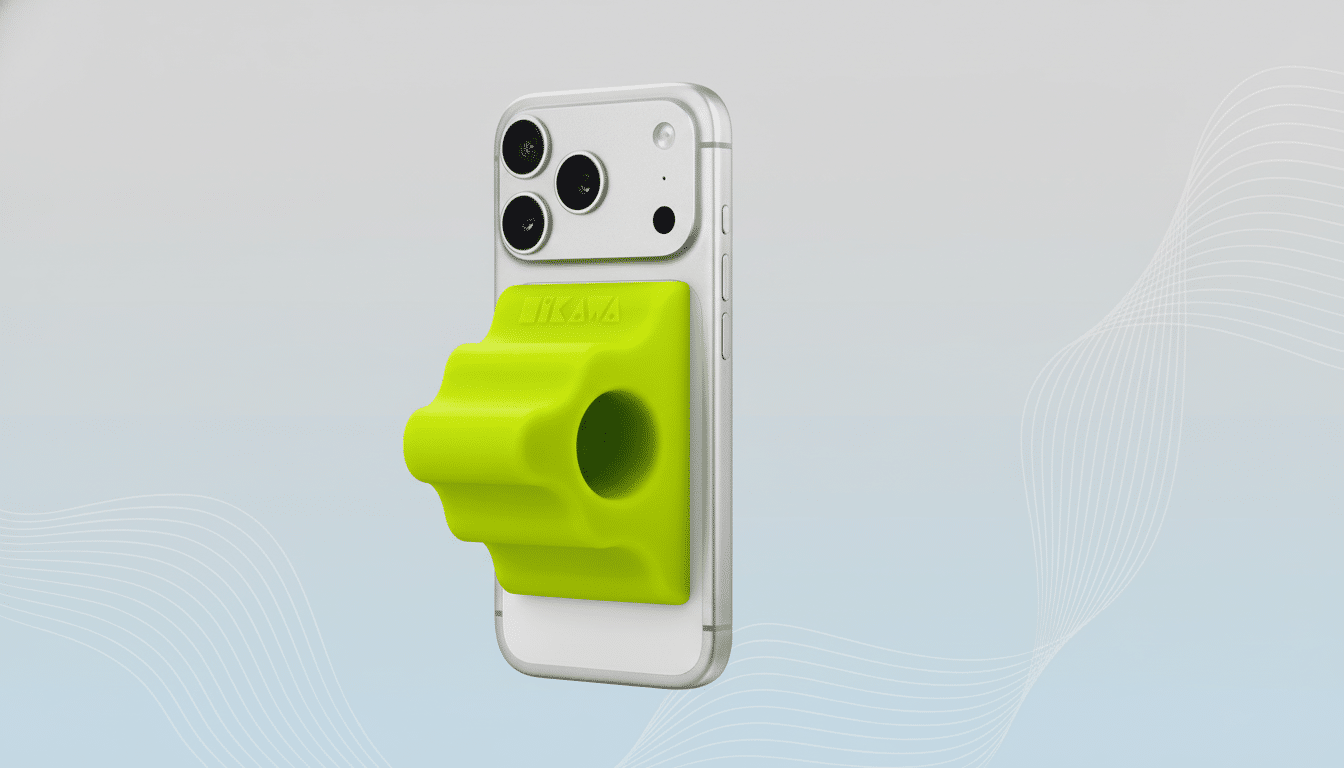Apple’s latest limited-edition accessory is a big swing at an everyday problem: how to hold a large iPhone comfortably and securely. The Hikawa Phone Grip & Stand, a $69.95 MagSafe attachment that snaps onto the back of compatible iPhones and doubles as either a portrait or landscape stand, leans heavily into Hikawa’s playful design while never losing sight of accessibility settings.
What Apple Is Really Selling with This MagSafe Grip
The handle is a silicone, triangular accessory with a hollowed middle designed for the finger. It magnetically attaches through MagSafe on iPhone 12 and later models or MagSafe cases, functioning as a stabilizing grip while also serving as a kickstand for hands-free viewing. The soft-touch silicone contributes a bit of cushion, helping extend the period that one-handed use can be comfortable and reducing fatigue, while the geometry allows you to change between grips without removing it.

Like many MagSafe grips, you’ll have to take it off to use a MagSafe charger. Apple hasn’t released dimensions or weight, but the small footprint is clearly optimized for pocketability, with a snapping on and off that’s less obtrusive. It’s available in two colorways — Chartreuse (a neon yellow-green) and Crater (an understated gray) — and sold exclusively through Apple’s online store as a limited release.
Inclusive Design Guided the Build from the Start
Designer Bailey Hikawa was tapped for the collaboration by Apple — and this wasn’t just a mere exercise in aesthetics. Hikawa collected feedback from people with muscle weakness, dexterity issues, and limited hand control, then developed the grip to accommodate multiple holding styles while also minimizing the effort required to steady an iPhone. The gratifying part, Hikawa said in an interview with Elle Decor, is to have seen that the form factor feels like a natural fit for hands of all sizes.
That approach is consistent with Apple’s overall accessibility portfolio — think VoiceOver, AssistiveTouch, and Reachability — built up over decades of investment. The Centers for Disease Control and Prevention notes that about 1 in 4 U.S. adults has a disability, so it’s worth noting: Inclusive design isn’t niche. A grip that reduces pinch force and distributes load on the fingers and palm may seem small, but for many users it can determine the difference between dropping a phone or using it with confidence.
How It Is Different Compared With Popular Grips
Already there are good options from PopSockets, Moft, and Belkin in the MagSafe grip category.
PopSockets’ MagSafe PopGrip and Moft’s snap-on stand-wallets tend to hit in the $30–$40 range. Belkin’s minimalist kickstands are frequently around $30. The premium on Apple’s entry is about 40 to 100 percent more than many third-party picks at $69.95.

What justifies that delta? Materials feel and magnet tuning matter — whether parallel to the plane for durability when propped up on a table or used one-handed. The ergonomics-forward shape of Apple’s design — and that they come from a pedigree of official accessory collaboration — will fit with fans of the same. And, because the grip is MagSafe-native, it ought to largely do away with the wobble and alignment issues you get when using an adhesive-based or non-MagSafe grip — especially on a larger device where leverage can really increase the impact of slight shifts.
Context also helps. That’s partly why big-screen phones are here to stay, with IDC pointing out that most new smartphones today have displays greater than 6 inches. And with larger screens, it becomes more difficult to hold the phone securely for long periods of time. A built-for-purpose grip is not only a stylish flourish — it’s an engineering response to the physics of contemporary phones.
Limited Edition and the Strategy Behind It
Apple has been playing around with short-run accessory drops, as in a recent sock-like pocket for the iPhone that blurred the line between bag and case. The Hikawa collaboration follows that pattern, a design-led moment meant not to find out if there is demand but to spark conversations around one’s willingness to create it, test demand, and show what accessibility thinking looks like in tangible hardware.
It also falls in with a tradition of eyebrow-raising Apple add-ons — from the $19 Polishing Cloth (seriously) to the Mac Pro Wheels, which cost several hundred dollars. The price point is arguable, but Apple’s limited-edition strategy can drive momentum and quick sellouts for bold colors with an inclusivity tie-in to design history.
Who It’s For and Early Takeaways After First Look
If you do a good deal of texting or scrolling with one hand, film vertical video, or switch between FaceTime calls and stand-up meetings, the Hikawa grip is made for your routine. They’re particularly useful for:
- Commuters, who can quickly shift between a handle and a stand
- Anyone whose phone always feels slippery
- Phones with smooth glass backs that benefit from added contact points
Third-party grips are still a great option for cost-conscious shoppers. But for people who desire an officially sanctioned, accessibility-informed take on a grip with a unique look, Apple’s limited-edition MagSafe offering is an interesting — and yes, quirky — way to make a big iPhone feel more like your own and less likely to fly out of your hand.

